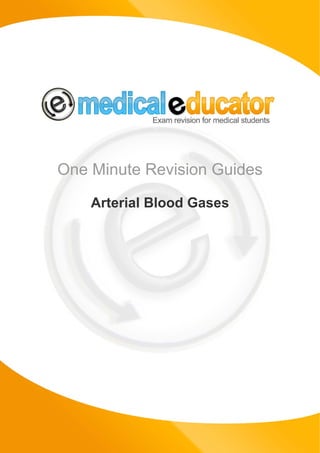Más contenido relacionado
La actualidad más candente (20)
Similar a Arterial blood gases - OSCE guide (20)
Arterial blood gases - OSCE guide
- 1. One Minute Revision Guides
Arterial Blood Gases
© Copyright Medical Educator Limited www.medicaleducator.co.uk
- 2. Arterial Blood Gases
When you see an arterial blood gas you should just think “marks in the bag”.
These are commonly found, easy to write questions that test knowledge.
ABG’s are shown as follows. I’ve listed some normal range values below.
pH 7.35-7.45
Pa O2 >10.5
Pa CO2 4.7-6
HCO32- 20-28
Base excess +/- 2
There are 3 key steps to interpreting a blood gas in your exams:
Step 1
• Does the result show ACIDOSIS/ ALKALOSIS or a NORMAL PH
If the pH is low i.e. <7.35 the patient is acidotic. Many FY1 doctors seem to “struggle with the
lower number meaning more acidy” but I have tried to convince several that yes, this is true
and no, I’m not making it up.
So pH<7.35 = Acidotic
7.35-7.45= Normal pH
>7.45= Alkalotic
Step 2
• Are the lungs doing something as a result of a “breathing” problem or in response to
another problem [for “breathing” think airway/lung substance/ nerves /muscles/
central drive to breathe]
So, what’s happened to the CO2? If it’s gone UP↑ then it implies that gas exchange through
the lungs is impaired. This most commonly happens because the lungs are under ventilated
for any one of a number of reasons (e.g. hypoventilation secondary to drugs (opiates) or
neuromuscular failure Guillan Barre Syndrome) etc.
For example: CO2 is 9.6. That’s high: the lungs must not be ventilating effectively.
Think airway/lung substance/ nerves /muscles/ central drive to breathe/ respiratory rate/ tidal
volume.
Examples of under ventilation causing a respiratory acidosis
Bronchospasm – eg, acute asthma
Reduced respiratory rate e.g. opiate toxicity
Chronic obstructive airways (reduced effective lung volumes and therefore tidal volume)
Muscular weakness: e.g. paralysis in GBS muscular dystrophy etc.
© Copyright Medical Educator Limited www.medicaleducator.co.uk
- 3. If the CO2 has gone down this implies that the lungs are working more efficiently. This is
because in general you will produce a reasonably constant amount of CO2 for the purposes
of considering questions in an exam.
So…. things which increase your respiratory rate (e.g. panic attack and hyperventilation) will
cause a primary respiratory alkalosis. If this is occurring in response to a metabolic acidosis
then this is a compensatory change.
Step 3
• What’s happened to the HCO3 2- ?
In a metabolic acidosis caused by any severe infection/ physiological stress/ acute renal
failure the amount of acid produced (e.g. lactate) by stressed organs will increase. As a
result of this the buffering system in the blood will compensate leading to a net fall in your
HCO3. This means in metabolic acidosis you tend to see the HCO3 go down.
The key fact to remember is that the kidneys regulate your HCO3 but cannot do it in the
space of a few hours. It takes days-weeks for them to regulate pH via changing HCO3 levels.
However an illness resulting in the production of rapid acid accumulation (e.g. ketosis in
diabetic ketoacidosis) will lead to a rapid fall in the HCO3 as it tries to compensate.
The “base excess” simply refers to how much extra base [alkali] you have in your body and
how much “acid” would be required to return your pH to normal. A negative base excess( e.g. -
10) occurs in acidosis, a positive base excess (e.g.+10) in alkalosis
So….
Changes in HCO3, when its elevated, usually relates to a chronic acidosis: most commonly
because of chronic obstructive pulmonary disease
HCO3 can fall quickly but cannot rise quickly
BLOOD ACIDS INCLUDE:
Lactate (produced during hypoxic stress)
Ketones (diabetic ketoacidosis, ethanol)
Urate (renal failure)
Examples
DKA Metabolic acidosis (ketone production) compensatory increase in respiratory rate
aiming to normalise pH CO2 falls.
If the CO2 falls sufficiently to normalise the PH then it’s a compensated metabolic acidosis
If it doesn’t normalise the pH then it’s a partially compensated metabolic acidosis
Examples
pH 7.23, Pa CO2 1.4, HCO3 2- 11.2 = partially compensated metabolic acidosis(DKA)
pH 7.44, Pa CO2 8.4, HCO3 2- 36 = compensated respiratory acidosis (e.g. COPD)
© Copyright Medical Educator Limited www.medicaleducator.co.uk

